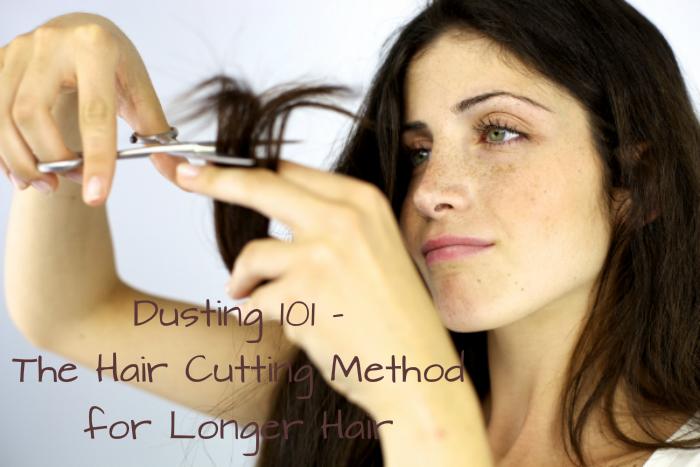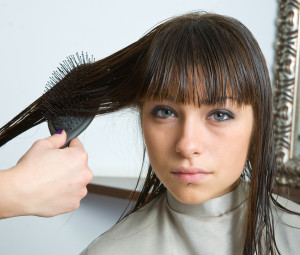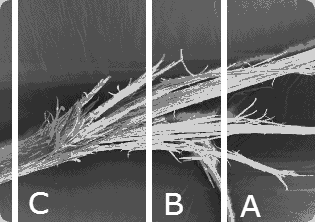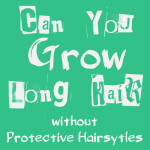Hello lovelies!

In order to grow long healthy hair, the ends of our hair need to be clipped or cut at some point, but when it comes to growing long hair, the advice on cutting can be pretty cut and dry, no pun intended. It’s either ‘Cut an inch from your hair every six to eight weeks,’ or ‘Don’t cut your hair at all.’ Personally, like most things, I find that dealing in extremes rarely offers you optimal results, and I like to find a happy medium that allows me to efficiently reach my goals with few to no speed bumps ahead, and in regards to cutting your hair for growth, dusting is that happy medium for me. Read on to find out why I think it’ll be a happy medium for your hair care regimen as well.
What is Dusting?
Dusting is a hair care practice where less than a quarter-inch is trimmed from the hair. With so little hair trimmed from the head, the gathered clippings resemble dust, hence the term ‘dusting,’ rather than the obvious and large clippings trimming or cutting the hair leaves behind. Dusting is simply an alternative to cutting large amounts of hair on a frequent basis, and dusting is most beneficial to people who are trying to retain as much length as possible and grow long, healthy hair.
How is Dusting Beneficial?
As I mentioned above, I don’t like dealing in extremes. In the past the ‘Cut an inch from your hair every six to eight weeks’ or ‘Don’t cut your hair at all’ advice never worked for me and in fact was counterintuitive to my long hair goals. Think about it. Since we know how fast hair grows, if you cut an inch off of your hair every six to eight weeks, you’ll cut off pretty much all of the hair growth you achieved in those six to eight weeks, leaving your hair at the same length. Since we know that all hair weakens at some point, if you never cut your hair at all, it’s only a matter of time before the oldest and weakest portion of the hair strand, the ends, breaks and splits, and you’ll only prolong the damage and possibly make it worse by not cutting and holding on to the ends of your hair. Dusting your hair will eliminate the downside of both scenarios.
Hair damage is inevitable, but if you’re following most of the hair care tips I share here, you’ve learned how to build a hair care regimen that has significantly slowed down the inevitable. As a result, this hopefully means that you’re experiencing fewer split ends and less overall damage, and if this is the case, a significant haircut or trim of an inch or more isn’t always necessary. However, not cutting your hair at all may result in more growth, but it won’t help your hair reach it’s fullest and healthiest potential if you hold on to old and worn ends. What dusting does is allows us to eliminate splits and other forms of damage before they even show up.
The average length of a split end is 1/20th of a centimeter; that’s pretty small! So small in fact that split ends and damage starts at such a microscopic level that it’s not visible to the naked eye. So by the time you’re able to see split ends, you can bet that your cuticle layer and the entire hair strand is severely damaged. When you dust, you remove those microscopic tears in the cuticle layer that leads to split ends and create ends that are whole and less susceptible to damage.
If you have a plant that has damaged and dead leaves, the number one way to bring that plant back to life is to cut off the scraggly leaves. When you prune the dead parts of the plant, the healthy portion of the plant is able to take up more nutrients and oxygen and thrive. Your hair is sort of the same! If you want to give your hair a fighting chance try dusting and stop most damage dead in its tracks so your hair can thrive and grow long.
Certain Hair Types Should Dust More Than Others
 Dusting may not be for everyone. Some people find dusting tedious and argue that their hair does just fine with the regular ole trim every 6 to 8 weeks method, and if that’s the case for you, well then more power to you. However, there are certain hair types that I just cannot see growing long without regular dusting, and that’s fine hair types. Because the structure of fine hair is vastly different than coarser hair textures, fine hair splits and breaks faster than any other hair type. So if you have fine strands, you need to dust even more than ladies with thicker, coarser hair strands.
Dusting may not be for everyone. Some people find dusting tedious and argue that their hair does just fine with the regular ole trim every 6 to 8 weeks method, and if that’s the case for you, well then more power to you. However, there are certain hair types that I just cannot see growing long without regular dusting, and that’s fine hair types. Because the structure of fine hair is vastly different than coarser hair textures, fine hair splits and breaks faster than any other hair type. So if you have fine strands, you need to dust even more than ladies with thicker, coarser hair strands.
How to Dust Your Hair
For starters, whether you’re cutting/trimming or dusting your hair, always and only use quality and sharp cutting shears that are specifically designed to cut hair. When dusting, only dust on dry hair. I would suggest that you separate your hair into four sections and clip each section off with a hair tie or clip. Then starting on one of the four sections, take smaller one-inch sections and trim the same amount, less than 1/4 of an inch. Once you cut a piece of hair, clip it out of the way and move on to another piece in the section. Once you finish one section, move on to the next until you’ve dusted all four sections. Repeat this process every 4 to 8 weeks depending on the thickness of your hair. Dust more frequently if you have a thicker hair type, and dust more frequently if your hair care regimen includes styling practices that may cause your hair to break faster (dust more often if you use heat or chemical processes to style your hair).
If you have curly or highly textured hair, dusting can be tricky because the ends of the hair curl, but here’s a simple solution. Simply put all of your hair into small, mini two-strand twists, and snip less than 1/4 inch from the end of each twist. If you have curly hair, this method will allow you to see and control how much you dust from your hair.
 Now if you haven’t let scissors touch your locks in a while (6 months or more), chances are your ends are worn and you need to start with a trim or haircut, not dusting. Dusting hair that hasn’t been cut or trimmed in a while won’t help much because you’ll only be trimming below the point of damage, and some damage will be left behind. For example, in the image to the left of a split end under a microscope, dusting at point A or B would leave some damaged ends behind, so there is no point in dusting at all in this case when your ends would still have some damage. To remedy all of the damage on the ends of the hair in the photo on the left, you’d have to cut the hair at point C where the hair strand is still whole and not split. Then after a fresh haircut or trim, you can incorporate dusting into your hair care regimen to keep damaged and split ends at bay in the future.
Now if you haven’t let scissors touch your locks in a while (6 months or more), chances are your ends are worn and you need to start with a trim or haircut, not dusting. Dusting hair that hasn’t been cut or trimmed in a while won’t help much because you’ll only be trimming below the point of damage, and some damage will be left behind. For example, in the image to the left of a split end under a microscope, dusting at point A or B would leave some damaged ends behind, so there is no point in dusting at all in this case when your ends would still have some damage. To remedy all of the damage on the ends of the hair in the photo on the left, you’d have to cut the hair at point C where the hair strand is still whole and not split. Then after a fresh haircut or trim, you can incorporate dusting into your hair care regimen to keep damaged and split ends at bay in the future.


